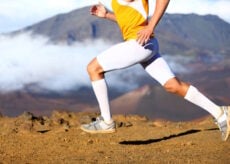The Best Workouts for People Over 40 (get fit as you age)

You might be over the so-called proverbial “hill” or “of a certain age,” but that doesn’t mean you have to throw in the towel when there are good fitness options for people over 40, 60, and beyond. And, with “40 being the new 20,” it’s time to work out smarter than ever before, keeping in mind the goals of staying healthy and avoiding injury and illness.
Here are some tips to help you focus on the best program for you.
What are Your Fitness Goals?
First and foremost, your ultimate goals will determine what kind of workout plan you follow. For example, are you trying to lose weight, get in shape, or stay fit? Or, are there health issues you’re either trying to improve upon or avoid?
How you formulate your plan of attack when it comes to your exercise plan will depend on your level of fitness now. Assess your level of fitness prior to jumping into a new routine. Do you have a history of exercise or a solid knowledge base, or are you a beginner? If you have been regular with exercise all along, then you may just need to tweak what you’re doing to better align with the outcome you desire (i.e., promoting cardiovascular health, shedding body fat, etc.).
If you haven’t been into exercise before and you’re just starting a workout plan, you’ll want to take it a little more slowly. It’s best to ease into this new chapter in your life and prevent injury by learning proper form and technique. It’s not that you can’t learn “new tricks,” but you just need to incorporate them into your routine with a little more caution.
Your exercise history, coupled with your future goals, will determine the best course of action for you when it comes to good fitness options.
What Fitness Plan is Right For You?
Cardiovascular fitness—if it’s aerobic conditioning you’re looking for, then a plan which incorporates both steady state and high-intensity interval training (HIIT) will be best.
Strengthening your bones—avoiding osteoporosis is a great idea and one very good way to do that is with a resistance training program.
Maintaining or achieving optimal blood sugar levels—avoiding issues with diabetes and maintaining blood sugar control is a good idea. Regular exercise can help.
Reducing body fat—if weight loss is your goal, then you can especially benefit from a regular program that combines both cardio and weight training with a healthy, lower-calorie nutrition plan.
Building muscle—this should be the goal of just about everyone over the age of 35. We lose muscle every year as we age, so rebuilding that metabolically active tissue is essential to maintaining proper function, fitness, and health as we age.
Take Things a Little More Slowly and Ramp Up Your Intensity
Yes, maybe you’re not exactly a spring chicken, but that doesn’t mean your goose is cooked. You can still engage in whichever forms of exercise you enjoy, but using a few of these tactics can help you smoothly transition into a workout program or continue your training regimen while reducing the likelihood of injury.
- Use lower impact exercises
- Ease back into the fitness scene
- Ramp up, but ramp up slowly
- Be consistent
- Warm up sufficiently
And, a few more things to consider when putting together a good fitness plan:
Keep your workouts balanced—this will help you with body balance too, preventing muscular imbalances, and addressing all aspects of a healthy lifestyle.
Explore new things—maybe you’ve never tried a yoga class (you absolutely must!) or maybe you always secretly wanted to do a Zumba class. Do it! Expanding your horizons and having fun, new experiences is good, not only for the body, but for the mind as well!
Keep it fun—Yes! Fun is an important ingredient in your fitness program. Try working out with friends or in a group setting. Or, get outdoors and enjoy!
Spring into Action to Avoid the Fall
As you get older, the risk of falls becomes a real thing. In order to prevent, or at least reduce, your chances of falling and being severely hurt, it’s important to focus on your posture, your exercise form, and correcting imbalances in your structure.
Now is the time to practice perfect form when you exercise, so you are less prone to injury. It’s also a great time to work on your balance. Speaking of balance, taking the time to assess and correct any imbalances in your physique could be well worth it as you work toward keeping your body fit, healthy, strong, and aligned.
Flexibility Is Important for People Over 40
Don’t forget about flexibility! They say that “flexibility is the fountain of youth.” Get involved in a good stretching program to help you lessen the chances of injury. Being flexible will also help improve your ability to balance as well as you lengthen and stretch tight muscles you may have from your resistance training routine.
Good Workout Options for 40+ Somethings
If you’re already solidly into a great routine, then by all means, keep on keeping on. But, if you’ve been out of the workout scene for a while, or you’re new to exercise, then here are some good workout options for you to try:
At Home Body Weight Workouts—Try this complete bodyweight workout to promote strength for all major muscle groups, enhance balance, and increase stamina. As a bonus, it can be adapted to your environment and you can easily increase or decrease the difficulty.
Walking—often overlooked and deemed not that effective, it turns out that walking is an excellent way to get, and stay, in shape. Not only does walking help keep you in shape, cardiovascularly, but even the low impact of walking helps strengthen your bones in the process. Just remember, if walking is your main mode of exercise, you still need to incorporate some sort of upper body training as well.
Tai Chi—this is a great way to work on your balance, reduce stress in your life, and improve your health markers. It’s a gentle and soothing martial arts practice that can greatly enhance your mood and boost your energy while increasing your cardiovascular fitness and even your muscular endurance.
Yoga—this practice is something any age group can participate in. Yoga gently challenges and stretches your muscles, helps you become flexible, and lubricates your joints. It is even said that yoga has the ability to “massage” every organ in your body through the various poses.
Pilates—with some similarities to yoga (such as balance, stretching, and flexibility work), Pilates works specifically on gently strengthening muscles.
Weight Lifting—this is not just a “good” option for people over 40, it’s essential. Since we lose muscle every year (up to 5% after age 30 if you’re inactive), it is vital that you replace that lost muscle by building new muscle tissue, and you do that with weight-bearing exercises.
Additionally, we lose bone mass as we age. Again, weightlifting comes to the rescue. It’s also been shown to improve metabolic rate, improve insulin sensitivity, promote better balance, and so much more.
Swimming—this is a fun, yet challenging, workout most folks can enjoy. Since it is a non-weight-bearing activity, it’s ideal for those with many types of injuries. You won’t even notice how much your aerobic capacity improves and how strong and toned your muscles become as you engage in this pleasant form of fitness training.
So, if you’d like to be strong, not weak; fit, not fat; able, not disabled, then it’s a good idea to choose at least one of these fitness options to pursue. With consistency and a gentle but progressive plan to keep moving forward, you can get or stay fit for many years to come—no matter how young or old you are today.








